2 Weeks in Kyushu
The most south-westerly of Japan’s 4 main islands, Kyushu is certainly off the beaten track and barely makes it onto the radar of many travellers and hopefully, it will stay that way. With a rugged coastline and mountainous centre, onsens galore and some of the best food in Japan, Kyushu is truly one of Japan’s highlights.
Getting to Kyushu
Kyushu’s main airport hub is in the northern city of Fukuoka. With good connections from across Asia, especially from China, South Korea and Taiwan, Kyushu is easily accessible for those in East Asia. Further afield and the number of direct flights drops dramatically. From further afield you will most likely fly through Seoul or Tokyo en route to Fukuoka.
Getting around Kyushu
The JR network here is pretty good with excellent connections between Kyushu’s major cities. However, to really explore the best bits of Kyushu is with your own set of wheels. This will allow you to access some of the island’s most stunning locations. We have an article on renting a car in Kyushu, however, if you want information on renting and driving in Japan we have an additional post on renting a car in Hokkaido.
However, it is very important to remember that you need an International Driving Permit (IDP) to drive in Japan. If you do not have an IDP then you are not going to be eligible for a refund when you arrive at the rental car depot.
We rented our car through the Japanese firm ToCoo.
When to visit Kyushu
Kyushu has a similar climate to Taiwan and Shanghai; hot, wet summers and cold winters. Like Taiwan and Shanghai, the best times to visit are spring and autumn, and understandably these are peak travel times. We visited in July which gave us scorching weather and a couple of huge typhoons. Japan is extremely well prepared for typhoons, but naturally, they can lead to road closures and landslides as per 2018.
Winter is certainly not as cold as in Hokkaido where the mercury regularly plunges below zero and the roads are hammered with snow. With the temperature hovering around the zero mark, winter could also be an excellent time to visit as the crowds will certainly be smaller than during the rest of the year.
What to do in Kyushu
In short, a lot. The itinerary below is what we did when we visited Kyushu. There were certainly things that we missed and we’ve detailed some of those at the end of the article.
Kyushu has numerous onsen regions, most notably the Oita region which is home to the very famous onsen town of Beppu as well as the smaller and prettier town of Yufuin. There are plenty more hiking areas than what we were able to visit; typhoons prevented visits to the Kirishima National Park and climbing Kaimon Dake at the very southerly tip of the island.
There is great reward in exploring the island. The coastline, particularly in the Miyazaki region is incredibly beautiful with numerous points that are worth checking out. Additionally, Unzen, Hirado, Takachiho and Kagoshima are littered with undiscovered gems.
Our itinerary
We began and ended in Fukuoka, Kyushu’s most captivating city. We were in Kyushu for a total of 15 days and whilst we were able to see a huge amount there was plenty we missed out on, most notably the island of Yakushima, Kirishima National Park, Dazaifu and the islands northeast.
Additionally, we have an article on budgeting in Japan to offer you a few money-saving tips and show that Japan is not as expensive as you think.
Day 1: Fukuoka
Starting in Kyushu’s main city of Fukuoka we spent the day exploring the city and wandering around the temple district very close to Gion subway station. Located in the Hakka half of the city the area is home to a stunning collection of temples and gardens, many of which are free. The largest temple in the area is the Tocho-ji Temple and in addition to being home to a gorgeous temple, it is also home to a stunning carved Buddha.
Fukuoka is home to some excellent cuisine, with the central area around Tenjin being jam-packed with excellent izakayas. The city is famous for its live squid sashimi, delicious if a little morally questionable.
Getting Around
Fukuoka has an excellent subway system with a variety of day cards and travel passes. To take the subway from international arrivals take the free bus outside and get off at the domestic terminal. Here you can jump on the subway to get into the city centre.
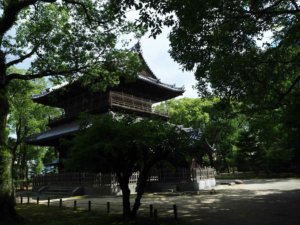
Day 2: Hirado
We picked up our hire car and headed west towards the port town of Hirado. We arrived early afternoon and headed straight for Hirado Castle. Expect awesome architecture and stunning coastal views.
At one point Hirado was the port of entry into Japan for Dutch traders and missionaries. However, this changed with the creation of Dejima in Nagasaki followed by Japan’s period of isolation.
We headed to Ji-in to Kyokai no Mieru Michi to check out the Dutch church and a couple of temples. The town has a bunch of secluded beaches and some excellent museums that are well worth checking out. Sadly our time was limited.
We then headed up to the Kawachi Pass which offers stunning views over the island. Despite the fact it had been raining most of the day we caught a break and had clear skies for a gorgeous sunset.
We could have easily spent 2 or 3 days exploring the island of Hirado, however, there were so many other awesome things to do in Kyushu!
We then drove on to Nagasaki where we had an Airbnb booked for 3 nights. Driving in Nagasaki is confusing. There are a number of toll roads, some of which are covered by the Kyushu Expressway pass, one-way systems and various other bits and bobs that can make it a hair-pulling experience. Fortunately, the drivers of Nagasaki were extremely forgiving to a confused tourist.
Parts of the city are made up of alleyways that work their way up the hills that surround the city. In places, these alleys are just slightly wider than the average car. Safe to say it was an interesting experience.
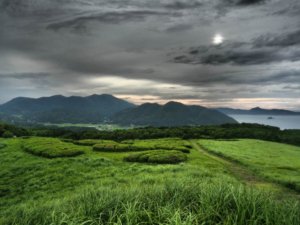
Day 3: Nagasaki
Nagasaki will always be synonymous with the events of August 1945, however, like Hiroshima, it has risen from the ashes and has developed into a gorgeous city with heaps to see and do.
We were greeted with our first typhoon and spent most of the day seeking shelter and drying our clothes, however, it certainly didn’t dampen our experience.
Although Nagasaki does not have a subway its tram network is excellent and can get you all over the city.
We first headed to the Atomic Bomb Museum and the accompanying Memorial Hall. Safe to say it was an incredibly moving experience and gives you insight into one of the most turbulent periods in history.
Sadly the typhoon closed Dejima so we spent the rest of the afternoon playing in a Japanese arcade.
Day 4: Mount Unzen
Fortunately, the typhoon had moved on we were left with clear blue skies for a day trip to Unzen.
We first headed to Mount Unzen and were treated to some lovely views en route.
There are plenty of hikes, however, the typhoon the previous day meant that there were a number that were inaccessible. However, after taking the cable car partway up, the trail to Mount Kunimi was still open. The trail is pretty easy until the end where you will need to use chains to get to the summit, but the views are worth it.
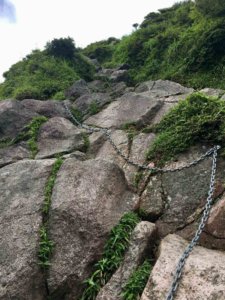
We then headed on to the town of Unzen and checked out some temples and Unzen Jigoku before heading to a public onsen which was easily the hottest onset we’ve ever experienced.
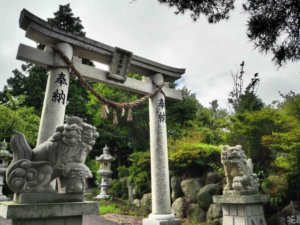
A tori gate in the town of Unzen
Day 5: Kumamoto
After visiting Peace Park in Nagasaki in the morning we drove to Kumamoto. You can take a ferry but be warned, it is expensive. When we hit a typhoon on the way down the further vindicated our decision to avoid the ferry.
Kumamoto is famous for two things; its stunning castle and the town mascot, Kumamon. Sadly the castle was badly damaged by an earthquake in 2016 and is still undergoing extensive repairs. Sadly visitors cannot go in, but Kumamoto is certainly a nice place to spend an afternoon.
The city has some decent museums and a fair few awesome restaurants.
Day 6: Chiran
For the majority of our drive down to Chiran, we had to contend with a huge typhoon on the highway. After passing through Kagoshima and continuing south we arrived in the small town of Chiran, famous for its old Samurai houses.
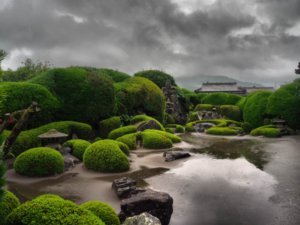
Interestingly the storm drains in the town are full of koi carp!
We then returned to Kagoshima where we stayed for 3 nights.
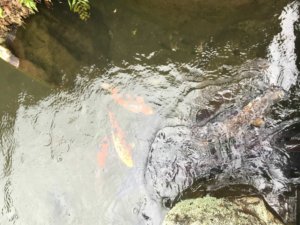
Day 7: Ibusuki
The typhoon of the previous day had moved on to pastures new. We began by heading to the Kamikaze Museum on the outskirts of Chiran for a fascinating insight into the Kamikaze division of the Imperial Japanese Airforce.
As the USA moved closer to Japan’s home islands, with Japan short on pilots, planes and raw materials leaders in Tokyo believed that the Kamikaze division would halt the American’s progress and potentially turn the tide of the war.
The excellent audioguides provide a lot of information on one of the most well-known military units in history.
From here we headed down to the small town of Ibusuki famous for hot sand bathing which we dutifully sampled. The sand spa was twined with a huge open-air onset perched on the edge of a cliff with amazing coastal views. Probably the best onsen we visited in Japan.
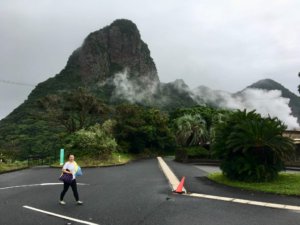
Day 8: Kagoshima
We finally had clear blue skies and took the opportunity to check out Kagoshima. It’s certainly not the biggest Japanese city but there’s enough to keep you occupied for the day. The waterfront has a bunch of free foot spas and great views of Sakurajima, which is consistently burping out ash.
For sunset head up to the hill to the east of the city for spectacular sunsets with some local cats.
Had the area not been hit by a typhoon Kirishima would have been the order of the day, however, there were numerous landslide warnings so we decided to play it safe.
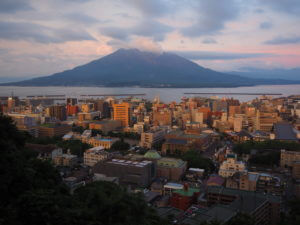
Day 9: Mount Sakurajima
A definite highlight of any trip to Kyushu is a trip to Sakurajima. A very active volcano just over the bay from Kagoshima, it is constantly pumping a little bit of ash into the sky.
From Kagoshima, the best way to get to Sakurajima is to take a 20-minute ferry across the bay. If not it’s an hour and a half drive.
Sakurajima is chock full of short hikes, free foot spas and awesome viewpoints. After spending the day exploring Sakurajima we head on towards the tiny surf town of Aoshima.
Outside of peak surf season, the town is deserted – a pleasant and eerie experience. That evening we headed out to explore the Aoshima shrine and sampled one of the region’s most unique dishes – chicken sashimi.
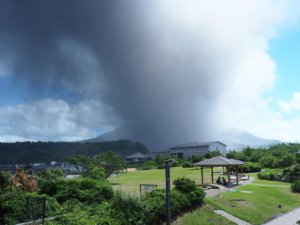
Day 10: Aoshima, Udo Jingu, and Hyuga
From Aoshima, we headed south to the Udo Jingu Shrine, which is probably one of the most stunning on the island.
We then headed north and spent the afternoon hiking around the Hyuga peninsula. Offering deserted trails and stunning coastal views this was definitely one of our most surprising finds. Kyushu itself is very much off the beaten track and this is off the beaten track on Kyushu, so go figure!
We then drove into the island’s centre, to the small town of Takachiho famous for its gorge of the same name.
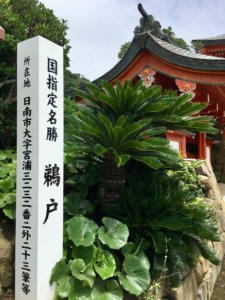
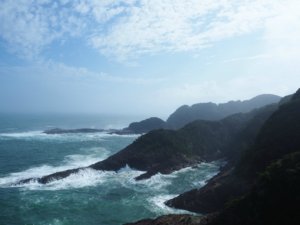
Day 11: Takachiho
Takachiho is absolutely gorgeous. Country roads wind their way through mountains, valleys and rice paddies.
We spent the morning in Takachiho Gorge. The trail from the car park through to the end of the gorge is certainly not one of the most strenuous hikes you will ever do. However, the views certainly are nice. You have the option to take a boat ride or sample a wide variety of local dishes including the famous flowing noodles.
From here we headed to the Takachiho shrine and onto a couple of stunning viewpoints that we found thanks to a combination of road signs and maps.me. We finished off our day by heading to the Amano Iwato Shrine.
For dinner, we headed to a tiny little izakaya close to the gorge where we had possibly the best chicken nanban in all of Kyushu.
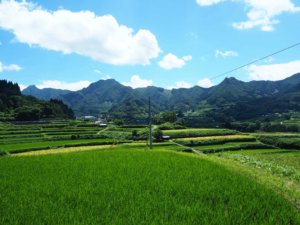
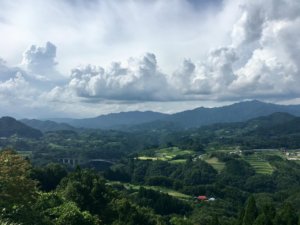
Day 12: Aso San
Aso San is stunning, however, we were unable to go up to the crater as the poisonous gas levels were too high. There are plenty of hikes and stunning views to be had. We did a couple of short walks and hot-footed it to our onsen hotel in the small town of Yufuin. We then spent the rest of the day soaking in onsens. Perfect.
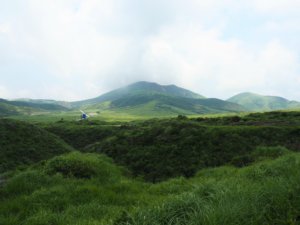
Day 13: Yufuin
With clear blue skies, I took the opportunity to hike to the top of Yufu-Dake a short but reasonably challenging hike offering stunning views of the town of Yufuin and the surrounding countryside. The trail is well marked, although take care when walking through the forest as it’s easy to get lost. After the forest section, the path is clear all the way to the summit. There are a number of peaks to check out, however, some of them will require nerves of steel to climb.
It took me around 4 hours total including a well-earned break at the summit. The last two-thirds of the hike is steep without any shade. If you are doing this trail in the summer like I was, take plenty of water and slather yourself in suntan cream.
Relaxing in an onsen that afternoon was a feeling of complete bliss.
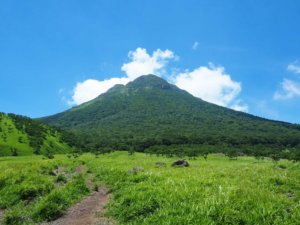
Day 14: Fukuoka
We dropped the car back to Fukuoka and got to our accommodation around 2 pm. We’d found a great hostel about 30 minutes by train from Fukuoka station. Every hostel, guesthouse, and Airbnb we found in the centre was in the region of 200 GBP a night! Certainly not what we’d experienced our first night in Fukuoka two weeks earlier. It turns out the next morning was the culmination of the Yamakasa Festival, one of Kyushu’s most important and vibrant. Teams push around huge floats, whilst being doused with water from those on the float and the crowd themselves. Festivities would begin at around 4:30-5 am the next day. Since our flight to Tokushima wasn’t until 10 we had plenty of time!
We spent the afternoon exploring the Tenjin and the Kushia Shrine.
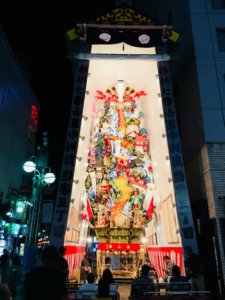
Day 15: Yamakasa Festival before flying to Tokushima in Shikoku
We jumped on a packed train at some ungodly hour of the morning and joined thousands of other sleep-deprived souls grabbing a spot. We were by no means the first there but we could see a reasonable amount. The only way to get a spot at the front is to stay in Fukuoka itself.
Everything calmed down just after 6 and after a quick coffee, it was off to the airport to take a flight to Tokushima on the island of Shikoku.
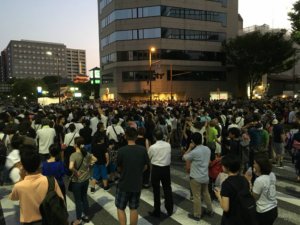
Anywhere we missed?
Dazaifu
This small town which is an easy day trip from Fukuoka is famous for its Buddhist Temples.
Kirishima National Park
This gorgeous National Park to the north of Kagoshima is one of Kyushu’s best hiking regions. Sadly when we visited typhoons had led to a warning of potential landslides meaning it was closed.
Kitakyushu
This city on the northern fringes of Kyushu is famous for its castle and gardens.
Kitamatsura Peninsula
The peninsula on which Hirado is located. This gorgeous expanse of land is pretty much deserted with plenty of places to explore.
Yakushima
This island south of Kagoshima is famous for its forests, hiking trails, and almost incessant rain. You can take a boat or plane from Kagoshima, but be aware that taking a car over is ferry expensive.
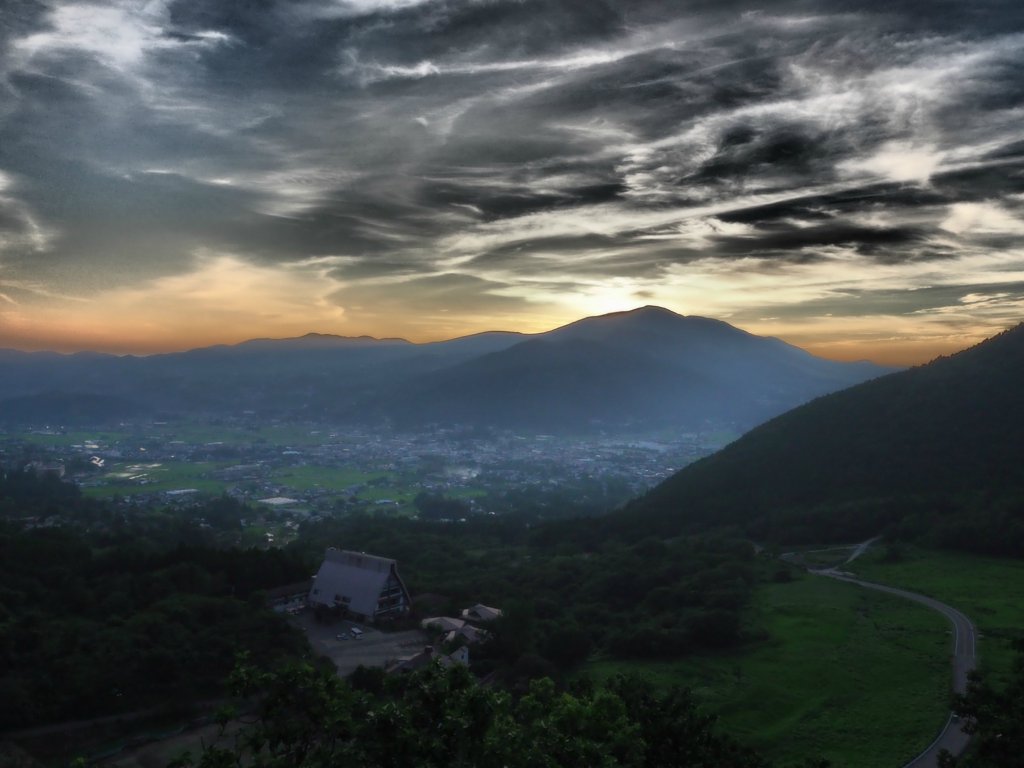
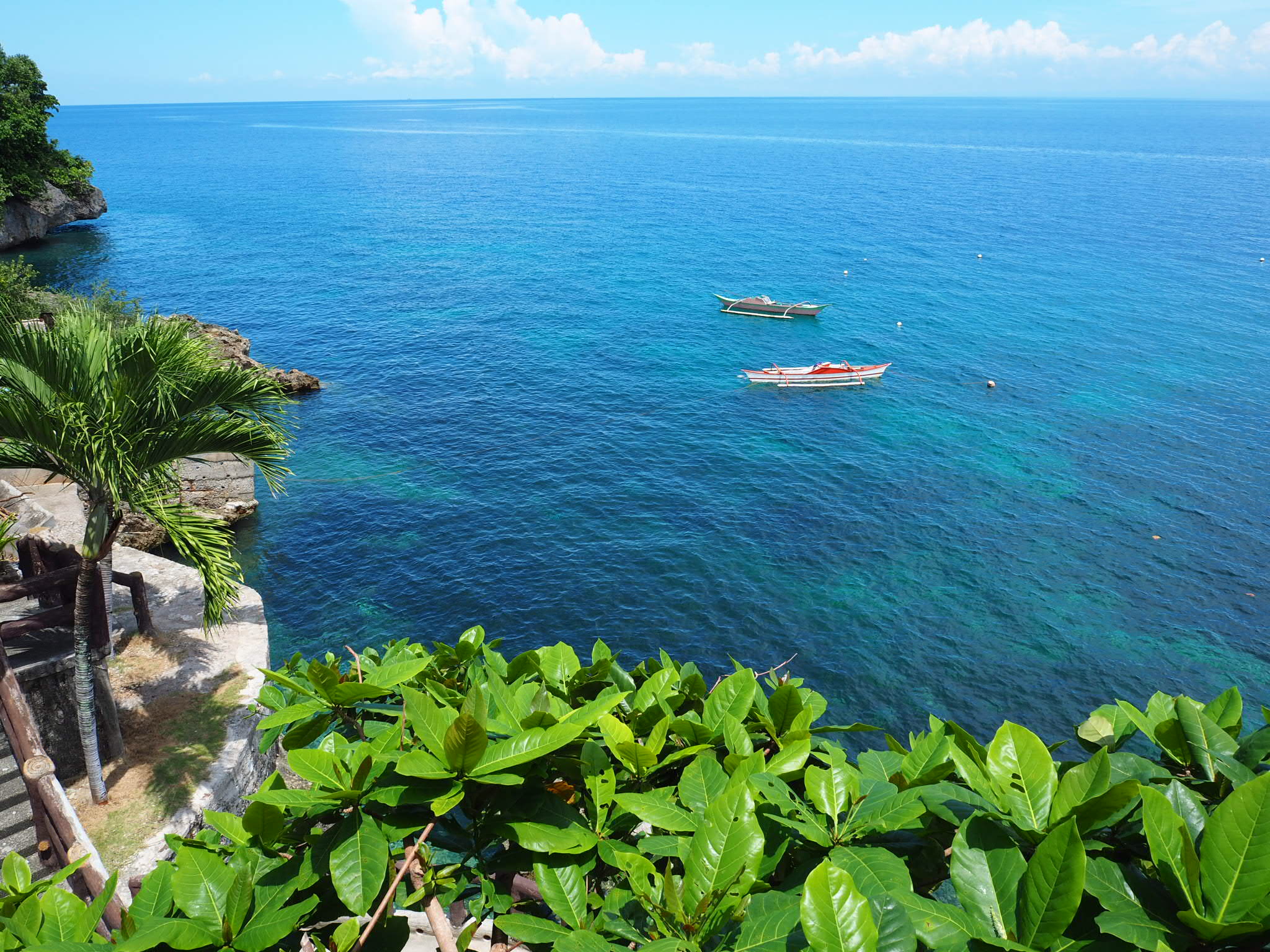
2 Comments
Well done guys, you fitted so much in and hit all the right spots! The only thing I might add is to include a visit next time to some of the wonderful old pottery villages here. Some of the families have been producing for 14 generations straight! Love the photos too.
Hi Simon, thanks for the kind words! It certainly is a beautiful part of Japan. Fingers crossed we will have the chance to head back there soon.